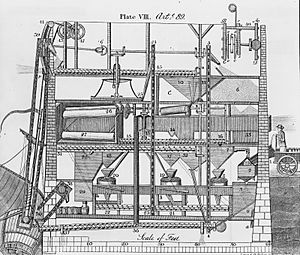Brandywine Village facts for kids
Brandywine Village was a very important place in the early days of American industry. It was located along the Brandywine River in what is now Wilmington, Delaware. The river here drops quite a bit, which was perfect for powering early factories and mills. This made it a great spot for making things like flour and gunpowder before steam engines were common. The river also connected to the Delaware River and Delaware Bay, allowing goods to be shipped out to sea.
Contents
How Brandywine Village Began
By 1687, a Swedish settler named Tyman Stidham opened the first mill on the Brandywine River near Wilmington. Around 1735, Brandywine Village itself was founded. It was built across the creek from Wilmington. Quaker families, like Elizabeth Levis Shipley, her husband William Shipley, and Thomas Canby, were key in starting the village and its flour mills. By 1743, Thomas Canby's son, Oliver, owned three mill sites. They had already built a dam and a special water channel called a millrace.
Growing as a Milling Center
Important Quaker millers, including the Canbys, Leas, and Tatnalls, built their stone homes along Market Street. They also built the Brandywine Academy building in 1798. A bell tower was added to the academy in 1820. Its bells rang when the Marquis de Lafayette visited on October 6, 1824. By 1806, the village had about 50 to 60 houses and around 12 mills.
In 1760, a bridge was built where the Market Street Bridge is today. Joseph Tatnall also built a northern millrace and two more flour mills.
Oliver Evans and New Inventions
Oliver Evans helped local mills become much more efficient in the 1780s. This was a big step in the Industrial Revolution. His first design for a fully automatic flour mill was used in 1783 on a nearby creek. Brandywine millers slowly began to use his ideas. With Evans's system, grain was unloaded on the ground floor. Waterpower then lifted it to the top floor. Gravity moved the grain through cleaning, drying, grinding, and cooling. This created a continuous process for making flour.
Other Industries in the Village
The first paper mill in Delaware opened in Brandywine Village in 1787. It was started by Joshua Gilpin, Thomas Gilpin, Jr., and Miers Fisher. This site later became home to one of the world's largest textile mills, Bancroft Mills, which is now closed.
In 1795, Jacob Broom built the first cotton mill on the Brandywine, a few miles north of the village. This mill burned down in 1797. In 1802, Broom sold the site to Eleuthère Irénée du Pont. Du Pont paid $6,740 for the land, which included a working dam and millrace.
The Du Pont Gunpowder Mills
Du Pont's gunpowder mills, known as the Eleutherian Mills, started operating in 1802. By 1810, this site was the biggest gunpowder maker in the country. During the American Civil War, over 4 million barrels of gunpowder were made here. The mills operated until 1921. Today, they are part of the Hagley Museum and Library.
Connecting to Other Areas
By 1796, Brandywine Village had 12 mills. They could grind 400,000 bushels of grain each year. By 1815, several toll roads connected the village to Pennsylvania's grain-growing areas. These roads later became parts of Delaware Route 41, Delaware Route 52, and US 202.
The millers worked together to keep their flour high quality and well-known. "Brandywine Superfine" flour was shipped all along the Atlantic coast. It also went to the West Indies before the American Revolution.
Brandywine Village Today
Brandywine Village became part of the City of Wilmington in 1869. Today, it is a historic district within the city. A mill race that once powered the mills is still working in Brandywine Park. This park was designed in the 1890s by Frederick Law Olmsted.
Images for kids





